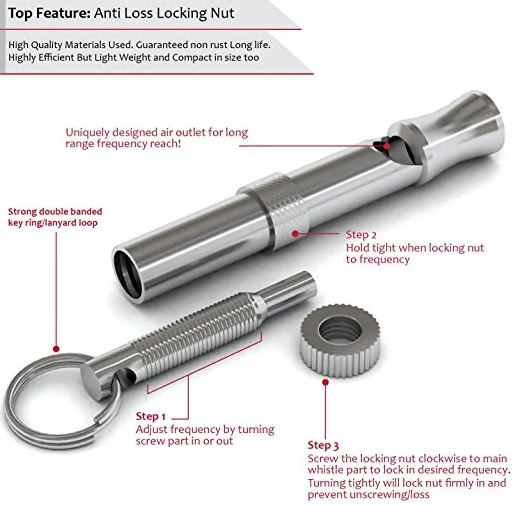
Training a dog using a dog whistle can be an effective and versatile approach. Follow these steps to harness the power of the dog whistle and embark on a successful training journey with your furry friend:
Step 1: Acquaint your dog with the whistle Introduce the dog whistle gradually to your dog in a positive and calm environment. Let them sniff and inspect the whistle, associating it with positive experiences like treats or praise. This helps build a positive association with the whistle.
Step 2: Establish a unique command Choose a specific command that will be associated with the sound of the whistle. For example, a short blast can indicate “come,” while a long, steady tone can represent “sit.” Consistency is key, so ensure that everyone involved in training uses the same command and whistle sound.
Step 3: Begin basic command training Start with basic commands such as “sit,” “stay,” and “come.” When giving the command, simultaneously blow the whistle, associating the sound with the desired action. Immediately reward your dog with praise or treats when they respond correctly. Repeat this process consistently, gradually reducing the need for verbal commands and relying more on the whistle cues.
Step 4: Reinforce recall with the whistle Recall training is crucial for a dog’s safety and obedience. When teaching your dog to come when called, use the whistle command and reward them when they respond promptly. Gradually increase the distance between you and your dog, ensuring they reliably come when they hear the whistle.
Step 5: Address specific behavioral issues The dog whistle can help address behavioral problems such as excessive barking, digging, or chewing. When your dog engages in unwanted behavior, use the whistle to interrupt them. Blow a sharp, distinctive sound to capture their attention and redirect their focus onto an alternative behavior or command. Consistency and timing are essential in helping them understand what behavior is undesirable.
Step 6: Advanced training and tricks Once your dog has mastered basic commands, you can use the whistle to teach advanced tricks or complex behaviors. By incorporating different whistle patterns and tones, you can communicate more nuanced commands, such as jumping through hoops or weaving through obstacles. Gradually build up the difficulty level and reward your dog for their achievements.
Step 7: Practice, consistency, and patience Training takes time, practice, and patience. Consistency is crucial for success. Use the whistle consistently for commands and be patient with your dog’s learning process. Regular practice sessions will reinforce their training and maintain their responsiveness to the whistle cues.
Remember, dog whistle training should always be positive and reward-based. Never use the whistle for punishment or as a tool for inflicting harm or fear on your dog. Seek professional guidance if you encounter challenges or need additional support in training your dog effectively.
With dedication, consistency, and the melodious guidance of the dog whistle, you and your four-legged companion can embark on a harmonious training journey, strengthening your bond and creating a well-disciplined and happy canine companion.
